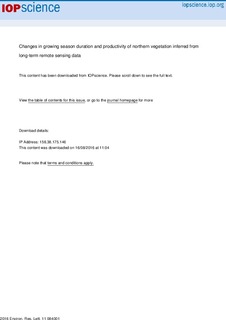| dc.description.abstract | Monitoring and understanding climate-induced changes in the boreal and arctic vegetation is critical
to aid in prognosticating their future.Weused a 33 year (1982–2014) long record of satellite
observations to robustly assess changes in metrics of growing season (onset: SOS, end: EOS and length:
LOS) and seasonal total gross primary productivity. Particular attention was paid to evaluating the
accuracy of these metrics by comparing them to multiple independent direct and indirect growing
season and productivity measures. These comparisons reveal that the derived metrics capture the
spatio-temporal variations and trends with acceptable significance level (generally p<0.05).We find
that LOS has lengthened by 2.60 d dec−1 (p<0.05) due to an earlier onset of SOS (−1.61 d dec−1,
p<0.05) and a delayed EOS (0.67 d dec−1, p<0.1) at the circumpolar scale over the past three
decades. Relatively greater rates of changes in growing season were observed in Eurasia (EA) and in
boreal regions than in North America (NA) and the arctic regions. However, this tendency of earlier
SOS and delayed EOS was prominent only during the earlier part of the data record (1982–1999).
During the later part (2000–2014), this tendency was reversed, i.e. delayed SOS and earlier EOS. As for
seasonal total productivity, we find that 42.0% of northern vegetation shows a statistically significant
(p<0.1) greening trend over the last three decades. This greening translates to a 20.9% gain in
productivity since 1982. In contrast, only 2.5% of northern vegetation shows browning, or a 1.2% loss
of productivity. These trends in productivity were continuous through the period of record, unlike
changes in growing season metrics. Similarly, we find relatively greater increasing rates of productivity
in EA and in arctic regions than inNAand the boreal regions. These results highlight spatially and
temporally varying vegetation dynamics and are reflective of biome-specific responses of northern
vegetation during last three decades.
photosynthetically active growing season, gross primary productivity, boreal and arctic, remote sensing, climate change,
AVHRR, MODIS | nb_NO |

